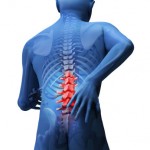Back Pain Relief For A Torn Disc
Orthopaedic surgeons have stated that in case of a disc tear, known as annular tear, it does not necessarily follow that acute pain will be associated with it. A disc tear is a common phenomenon that occurs with ageing, so many of us could develop a disc tear in our lifetime. Traumas associated with an annular tear may lead to restricted movements in lifting, twisting, and other movements in our daily life. While some may not show any symptoms, others may experience acute pain down the buttocks right up to the legs.
Doctors prescribe alternate methods of treatment through the application of heat and cold packs, taking rest, and having anti-inflammatory drugs as back pain relief for a torn disc. The last resort should be surgery. Doctors also advise that if you have to go for surgery, traditional and conservative methods that involve open surgery should be avoided. Instead, you should opt for the latest technique involving surgery using an endoscopic discectomy. This procedure involves X-ray imaging, and the tool assists in performing surgery at the exact location in the lumbar disc. Following this treatment, the patient is released the same day.
Back Pain Relief For A Torn Disc
It sure sounds terrible: A tear in the tough outer shell, also known as the annulus, of one of the discs in your spine-the discs that act as spacers and shock absorbers between the bony vertebrae, allowing us to bend and move, lift and squat, twist and turn. An annular tear must send you straight to the doctor, screaming in pain. Right? Not necessarily, says Kaixuan Liu MD, PhD, chief surgeon at Atlantic Spinal Care in Edison, N.J.
“Virtually everyone will develop disc tears at one time or another, simply because we all age,” says Dr. Liu. A disc can be damaged though a violent injury, he explains, but most disc tears are the result of the normal aging process combined with the tiny traumas of everyday life; lifting, twisting, and other movements. Genetics and lifestyle also seem to play a role.
When you do tear a disc, in many cases, you’ll never even know it’s happened. Research has shown that torn discs are fairly common-and that they often don’t produce any symptoms at all. In one study of pain-free people, more than a third had annular tears. “We really don’t know why some people have pain and others do not,” says Dr. Liu.
Torn Disc Treatment Options and Operations
A patient with a torn disc can feel a great deal of pain-in the lower back (near the damaged disc) as well as radiating through the buttocks, legs, and feet. Numbness, tingling, and muscle weakness are also common symptoms.
If your torn disc is causing problems, Dr. Liu first recommends a conservative, non-surgical approach, which includes anti-inflammatory medicine, rest, ice or heat therapy, and physical therapy. “Surgery is usually a last resort,” he says, as conservative treatment works for all but about 10 percent of patients.
If you do need surgery, Dr. Liu says, you’ll have a few options-and luckily, one of them is a new, minimally invasive technique that will have you back to normal in next to no time.
“Traditional torn disc surgery is an ‘open’ procedure, in which the surgeon cuts through skin and muscle to gain access to the affected area,” Dr. Liu explains. That type of operation involves a long recovery time, a hospital stay and large doses of pain medication. In addition, there’s the risk of complications and other side effects that come from general anesthesia.
“We prefer to operate on disc tears using an endoscopic discectomy,” he says, “which incorporates x-ray imaging and special surgical tools that allow us to remove only what’s necessary to relieve the patient’s pain.”
In this procedure, the surgeon uses a metal tube roughly the size of a pencil and a tiny camera (endoscope) to find the torn disc. A small annular tear can be treated with a laser; if there are any larger pieces of herniated disc, they will be pulled out with a grasper. Then the tube is removed, the incision is closed with a stitch or two, and the patient is on his or her way the same day.
What happens when a disc tears
When the annulus tears, the gelatinous material inside the disc (the nucleus) can move into the disc’s outer layer, forming what’s known as an interpositional disc herniation. If it moves through to the outside of the disc annulus, this is called a disc herniation. And a tear that’s progressed to that stage can produce all levels of pain, from mild and intermittent to excruciating, says Dr. Liu. What’s more, he says, new research is showing that annular tears are often a sign that degradation of the disc nucleus, a sign of more serious degenerative disc disease, is on its way.
If an annular tear has to be operated on for back pain relief for a torn disc, then it is best to opt for endoscopic discectomy because this process is the safest and less time-consuming surgery, which is carried out with the aid of the latest technology. Of course it is best to try and avoid surgery by trying every possible option to heal your disc injury, and often strengthening exercises can help support the back and alleviate pain.
The video by StrykerInterventionalSpine.com provides information about a minimally invasive discectomy operation.
In this incredible video Dr Donald S. Corenman, M.D. performs a Lumbar Micro Discectomy surgery.
For more information on back surgery and ways to avoid it get your free copy of The 7 Day Back Pain Cure by back expert Jesse Cannone. Sign up below to receive your free hardcover copy.
You might also like:
Tags: Back Pain Relief For A Torn Disc, disc herniation, slipped disc, Treatment















